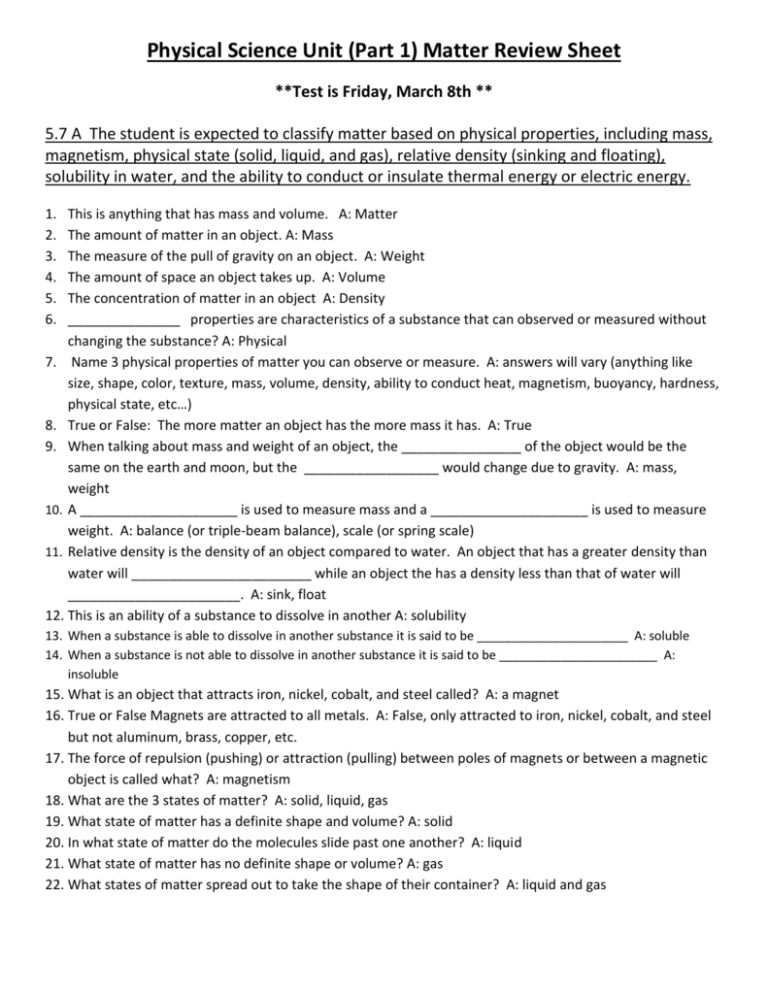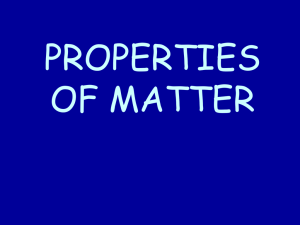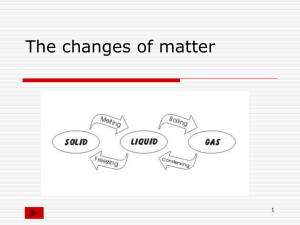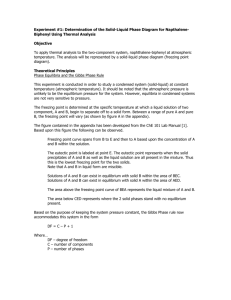Physical Science Unit (Part 1) Matter Review Sheet **Test is Friday
advertisement

Physical Science Unit (Part 1) Matter Review Sheet **Test is Friday, March 8th ** 5.7 A The student is expected to classify matter based on physical properties, including mass, magnetism, physical state (solid, liquid, and gas), relative density (sinking and floating), solubility in water, and the ability to conduct or insulate thermal energy or electric energy. 1. 2. 3. 4. 5. 6. This is anything that has mass and volume. A: Matter The amount of matter in an object. A: Mass The measure of the pull of gravity on an object. A: Weight The amount of space an object takes up. A: Volume The concentration of matter in an object A: Density _______________ properties are characteristics of a substance that can observed or measured without changing the substance? A: Physical 7. Name 3 physical properties of matter you can observe or measure. A: answers will vary (anything like size, shape, color, texture, mass, volume, density, ability to conduct heat, magnetism, buoyancy, hardness, physical state, etc…) 8. True or False: The more matter an object has the more mass it has. A: True 9. When talking about mass and weight of an object, the ________________ of the object would be the same on the earth and moon, but the __________________ would change due to gravity. A: mass, weight 10. A _____________________ is used to measure mass and a _____________________ is used to measure weight. A: balance (or triple-beam balance), scale (or spring scale) 11. Relative density is the density of an object compared to water. An object that has a greater density than water will ________________________ while an object the has a density less than that of water will _______________________. A: sink, float 12. This is an ability of a substance to dissolve in another A: solubility 13. When a substance is able to dissolve in another substance it is said to be ______________________ A: soluble 14. When a substance is not able to dissolve in another substance it is said to be _______________________ A: insoluble 15. What is an object that attracts iron, nickel, cobalt, and steel called? A: a magnet 16. True or False Magnets are attracted to all metals. A: False, only attracted to iron, nickel, cobalt, and steel but not aluminum, brass, copper, etc. 17. The force of repulsion (pushing) or attraction (pulling) between poles of magnets or between a magnetic object is called what? A: magnetism 18. What are the 3 states of matter? A: solid, liquid, gas 19. What state of matter has a definite shape and volume? A: solid 20. In what state of matter do the molecules slide past one another? A: liquid 21. What state of matter has no definite shape or volume? A: gas 22. What states of matter spread out to take the shape of their container? A: liquid and gas 23. Draw what the molecules look like in a solid, liquid, and gas. solid liquid gas 24. What is a conductor? A: a material that allows energy to pass through it easily 25. What is an insulator? A: a material that does not allow energy to pass through it easily or not at all 26. What are conductors and insulators of heat? A: conductors- metal, some plastics insulators- fabric, wood, some plastics, air, anything with air spaces 27. What are conductors and insulators of electricity? A: conductors- metals insulators- air, plastic, wood, rubber, anything not metal 28. Classify the following materials according to the physical properties: Type of Matter Magnetic or Nonmagnetic Physical State of Matter Sink or Float Conductor or insulator of: Heat Electricity plastic cup salt brass brad water air Resources to help you study: Online Science Textbook: Chapter 10- Lessons 1, 2, and 3 Notes in Science Notebook Brain POP Videos: Measuring Matter, States of Matter, Magnetism, Electric Circuits, Heat, Water 5.7 B The student is expected to identify the boiling and freezing/melting points of water on the Celsius scale. 29. What is the freezing/melting point of water? A: 0 C, 32 F 30. What is the boiling point of water? A: 100 C, 212 F 31. The freezing point and boiling point of a substance is _________________________ A: constant 32. True or False: The boiling point of water changes depending on the volume. A: false 33. True or False: The freezing point of a pure substance is always the same regardless of the amount or it’s mass. A: True 34. The boiling or freezing points of a substance change depending on how much heat you add or remove and how long it takes to reach that temperature A: false Resources to help you study: Online Science Textbook- Chapter 10 Lesson 3 Science Notebook: chart in notes Brain POP Videos: Temperature, Measuring Matter 5.7 C The student is expected to demonstrate that some mixtures maintain physical properties of their ingredients such as iron filings and sand. 35. This is a combination of two or more different kinds of matter, each of which keep their own physical properties. Give an example. A: mixture, in a mixture of cereal and raisins the cereal and raisins each keep their own physical properties that they had before mixing, other examples: salad, trial mix, iron filings and sand 36. True or False: Examples of mixtures include sand, salad, trail mix, and a mixture of sugar and iron filings. A: true 37. Mixtures are usually easy to ______________________ and can often be done by picking the ingredients out by hand. A: separate 38. Can you separate mixtures using the physical properties of substances? Give an example. A: Yes. For a mixture of sand and iron filings you can use the property of magnetism and get a magnet to separate the mixture. 39. True or False: In a mixture, each kind of matter keeps its own physical properties. A: True Resources to help you study: Online Science Textbook- Chapter 10 Lesson 4 Science Notebook Brain POP Videos: Compounds and Mixtures 5.7 D The student will identify changes that can occur in the physical properties of the ingredients of solutions such as dissolving salt in water or adding lemon juice to water. 40. When a substance mixes completely with another substance to form a solution it is said to ________________. A: dissolve. 41. A ____________________________________ is a type of mixture in which particles of the two substances are evenly mixed; some of the physical properties change. A: solution 42. This is a combination of two or more kinds of matter in one substance dissolves in another and there can be changes in the physical properties. Give an example A: solution, in a solution of Kool-Aid, the Kool-Aid powder may have been pink, a powder, cherry flavored and the water was clear, taste-less, a liquid and when you mix them their properties change- the Kool-Aid powder dissolves in the water and the it is no longer a powder and is no longer pink but red, and the water is no longer clear but red and also is no longer tasteless but tastes like cherry. Some properties stayed the same like the flavor of the kool-aid is still cherry and the water is still a liquid. 43. A solution is a special kind of __________________________ A: mixture 44. True or False: Examples of solutions are saltwater, chocolate milk, Kool Aid, brass, and air A: true 45. Solutions can be separated but are usually a little _____________________ to separate than mixtures. A:harder 46. Can you separate solutions using the physical properties of substances? Give an example. A: Yes. For a solution of sugar and water you can use the property of physical state and let the water change states (evaporate) and you will be left with the sugar. Resources to help you study: Online Science Textbook-Chapter 10 Lesson 4 Science Notebook Brain POP Videos: Compounds and Mixtures, Property Changes (3.5C) Matter and energy. The student will predict, observe, and record changes in the state of matter caused by heating or cooling. Change in States of Matter 47. Change in state of matter is what kind of change? A:physical 48. Changing states of matter is caused by what? A: adding or removing heat 49. When you add or remove heat what are you adding or removing? A: energy 50. True or False: When you add or remove energy it affects the movement of the molecules and causes a change in state of matter. A: True 51. Changing from a liquid to a gas is called what? A: evaporation 52. Changing from a gas to a liquid is called what? A: condensation 53. Changing from a solid to a liquid is called what? A: melting 54. Changing from a liquid to a solid is called what? A: freezing 55. The temperature at which a liquid turns to a solid is called what? A: freezing point 56. The temperature at which a solid turns to a liquid is called what? A: melting point 57. True or False: The freezing and melting points for a substance are the same. A: True 58. The temperature at which a liquid turns to a gas is called what? A: boiling point Physical and Chemical Changes 59. This kind of change does not create any new substances A:physical change 60. True or False: Change in state of matter is an example of a physical change A: true 61. This kind of change does create one or more new substances A: chemical change 62. Tell if the following examples are physical changes or chemical changes: a. Cutting a pizza in half- physical b. Freezing ice into ice cubes- physical c. Baking a cake- chemical d. A metal bench rusting- chemical e. Boiling water for hot cocoa- physical f. Burning wood in a fire place- chemical g. Melting a crayon- physical Resources to help you study: Online Science Textbook-Chapter 10 Lesson 5 Science Notebook Brain POP Videos: Matter Changing States, Property Changes









